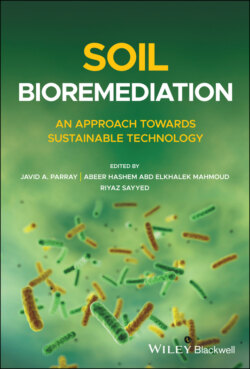Читать книгу Soil Bioremediation - Группа авторов - Страница 20
2.1 Introduction
ОглавлениеPhytoremediation is a leading technology that helps to resolve the issues related to toxic metal removal with the help of a green revolutionary technique. In a green revolutionary technique the best genetically appropriate plants assist removal of toxic metals from contaminated soil. These plants can degrade, remove, immobilize, or metabolize toxic metal in a wide range of areas, e.g., wetland or a terrestrial land system. Phytoremediation is not a new technology. Almost 300 years ago different types of plants species were utilized to clean‐up wastewater [1]. At the end of the nineteenth century, Thlaspi caerulescens and Viola calaminaria were the first plant species that were documented to accumulate high levels of metals in their leaves [2]. In 1935, Byers reported that plants of the genus Astragalus could accumulate up to 0.6% selenium in dry shoot biomass. One decade later, it was identified that plants could accumulate up to 1% Ni in shoots [3]. In the last decade, extensive research has been conducted to investigate the biology of metal phytoextraction. Metal hyperaccumulation is a phenomenon generally associated with species endemic to metalliferous soils, and it is found in only a very small proportion of such metallophytes. Furthermost, but not all, hyperaccumulators are strictly endemic to metalliferous soils. More than 430 taxa are described to date in all continents in temperate and tropical environments. Notable centers of distribution are: Ni – New Caledonia, Cuba, South East Asia, Brazil, Southern Europe, and Asia Minor; Zn and Pb – Europe; Co and Cu – Southcentral Africa. Some families and genera are particularly well represented, i.e., for Ni: Brassicaceae (Alyssum and Thlaspi), Euphorbiaceae (Phyllanthus, Leucocroton), and Asteraceae (Senecio, Pentacalia); Zn: Brassicaceae (Thlaspi); Cu and Co: Lamiaceae and Scrophulariaceae. Phytoremediation can be practiced to scavenge both organic and inorganic pollutants present in solid substrates (soil), liquid substrates (water), and the air.
Phytoremediation is a comprehensive technique, which offers heavy metal (HM) contamination remediation with an innovative and cost‐effective option. The use of plants to bring back contaminated sites is termed as phytoremediation as it uses the plant’s natural characteristics to up take, accumulate, store, degrade, and remediate heavy metals [4]. With the green revolution, use of pesticides and fertilizers has polluted the soil with HMs like Cd, Pb, Ni, and Hg. Pesticides, beside their biocidal and fertilizing effects, contain considerable concentrations of HMs. Undeniably, pesticides can be very toxic and are responsible for farming diseases such as cancers and neurodegenerative diseases. However, in developed countries, there is a rapid change from subsistence farming to intensive farming, in order to feed more people. There are also some issues like lack of selectivity, overuse, and over exploitation that leads to risk for living organisms and humans by contaminating drinking water, food, and soils. Their presence in soil, water, plants, and even the atmosphere, together with their potential pharmacodynamic properties, can have harmful effects on the environment and on human health [4, 5]. This problem can be overcome by phytoremediation, which can reduce HM pollution and decrease their impact on the environment [5]. These techniques are exciting prospects for reducing environmental pollution. Plants can bioaccumulate, biotransform, and bioremediate HMs [6]. Unlike organic compounds, heavy metals cannot be degraded. Hence, an effective clean‐up strategy via immobilization is required to reduce or remove toxicity. In recent years, scientists have commenced generation of cost‐effective technologies that comprise use of microorganisms/biomass or live plants to clean polluted areas. These technologies are best applied at sites with shallow contamination of organic, nutrient, or metal pollutants that are acquiescent to one of the five applications, i.e., phytotransformation, rhizosphere bioremediation, phytostabilization, phytoextraction, and rhizo‐filtration. The technology involves efficient use of plants to remove, detoxify, or immobilize environmental contaminants in a soil, water, or sediment mix through the natural, biological, chemical, or physical activities or processes of the plants [7]. The exploitation of plants to remediate soils contaminated with trace elements could offer a cheap and sustainable technology for bioremediation. Many modern tools and analytical devices have provided insight into the selection and optimization of the remediation process by plant species. Metal‐hyperaccumulating plants, desirable for heavily polluted environments, can be established by the insertion of novel traits into high biomass plants in a transgenic approach, which is an encouraging strategy for the development of effective phytoremediation technology. The inherited manipulation of a phytoremediator plant needs many optimization processes, including mobilization of trace HM ions, their uptake into the root, stem, and other viable parts of the plant and their detoxification and allocation within the plant [8, 9].
